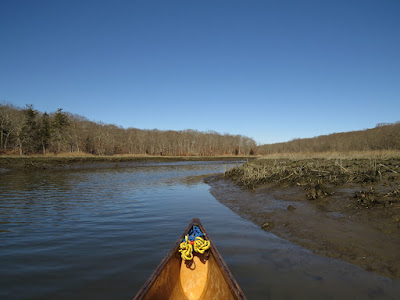I put in from the wildlife refuge "ramp" such as it is. It is foggy and near 40F with the temperature rising, as is the tide which has another hour and a quarter to go before peak. I flush about 75 Canada Geese while getting started. A harrier flies by with a smaller bird harassing it. With the backlighting, I can't ID the litle bird until it pulls up into a hover - Kingfisher.
I set out across the bottom of the marsh. Once I'm 50 yards from shore, the east wind starts pushing me. It is stronger than the weather prediction, and feels like something just shy of 15 mph. As I paddle the 1/2 mile over to the bottom of Nell's Channel, flocks of Geese and Black Ducks take wing. Sometimes, I'm close enough to blame, and sometimes they are way too far off for me to be the cause. In the fog, the best navigation landmark is the big speed limit sign at the entrance to the channel. It has a particularly shaggy immature Bald Eagle perching on it.
The sun has burned through by the time I get to the channel.
I head up the channel, figuring out soon that I want to cross over to the east side of the channel and paddle in the six foot strip of smoother water next to the bank. There's nowhere for me to hide from the crosswind, but the foot high bank does make a difference on my 16 foot canoe.
I head up into Beaver Creek, which for once is almost devoid of any birds. I come back and take the shortcut over to Cat Island. The last 50 yards are a stiff push as the minimal water path is choked with a winter's worth of dead reeds and grasses. Likewise for the route around the back of the Island, which requires a bit of wading today. I flush a Great Blue Heron while I'm back there.






























